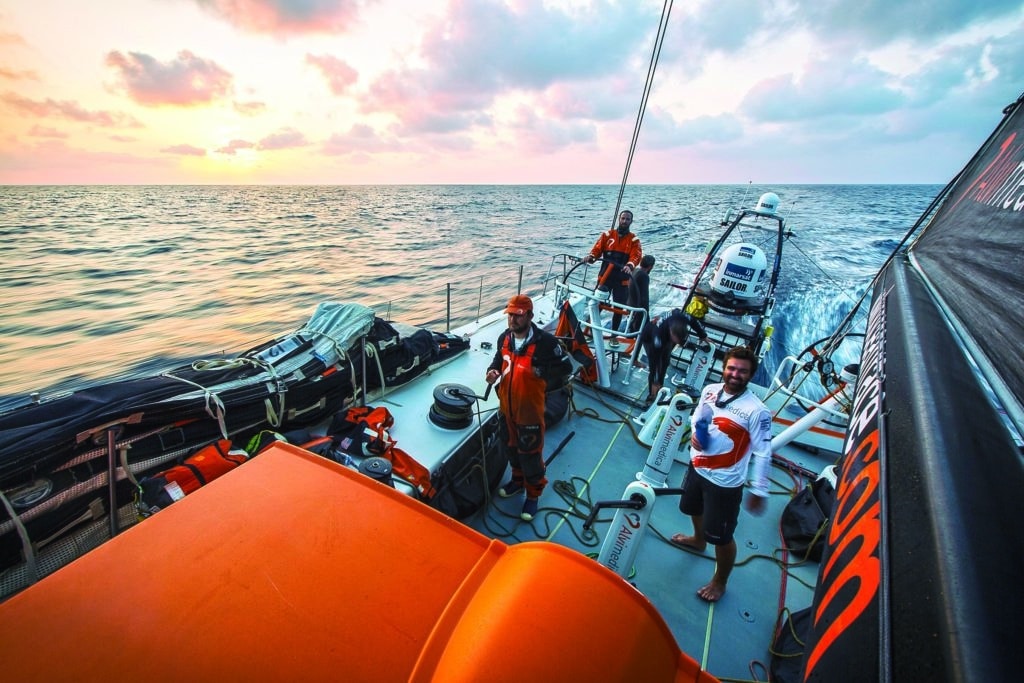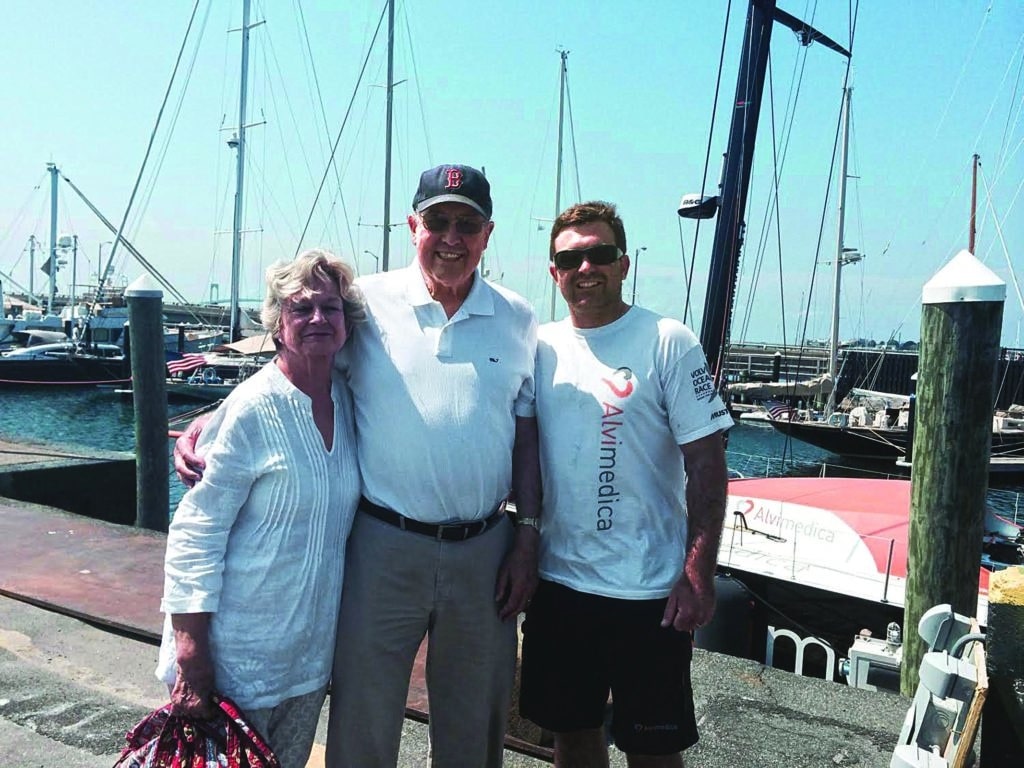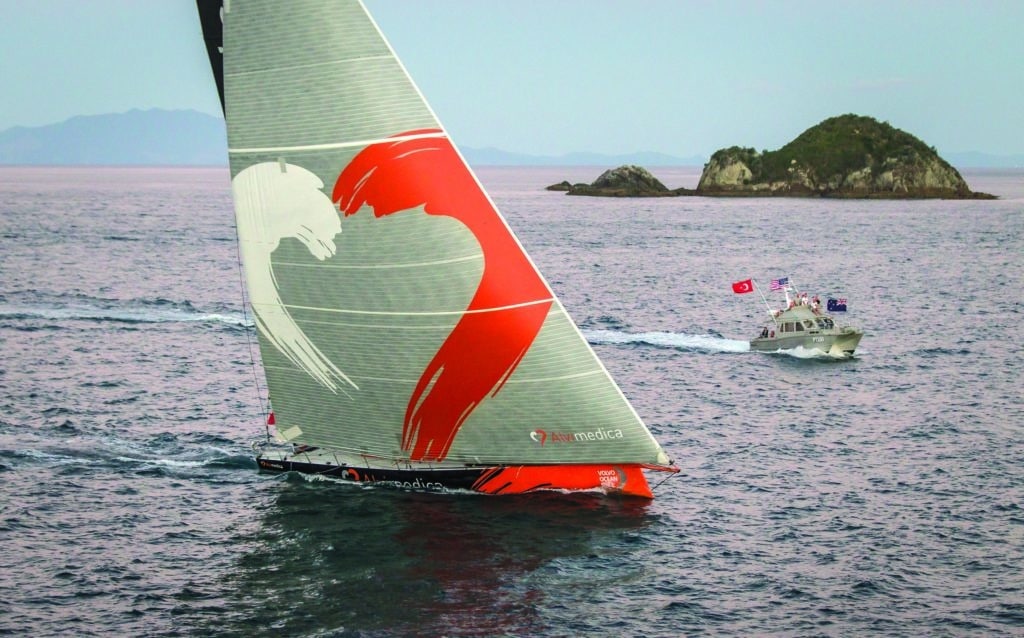In 1987 Clinton Pearson placed his 3-year-old grandson, Charlie Enright, into a small sailing dingy, attached a line to the boat and pushed the boy out onto the water. Pearson steered the skiff from the shore by pulling on the line in different directions.
“He seemed to like it; we had a pleasant afternoon down by the water that day,” Pearson recalls. “I didn’t know one day he would grow up and skipper a Volvo Ocean Race boat, but I am proud of him.”
Twenty-eight years and thousands of offshore racing miles later, Enright is at the helm of Team Alvimedica, with the youngest crew of the seven teams in the grueling nine-leg Volvo Ocean Race, which covers over 38,000 miles around the globe. By May, the sailors will have rounded Cape Horn, enjoyed a layover in Itajaí, Brazil, and will be on their way to the only U.S. stopover, in Newport, Rhode Island, where Enright and crew will arrive as hometown heroes. You can be sure granddad Clint will be there to welcome them. After all, racing has long been a family tradition for the Pearson clan.
Clint Pearson, founder of both Pearson Yachts and Bristol Yachts, has been an innovator in the sailing industry for over five decades. A Brown University alumnus, he attended school on an ROTC scholarship prior to spending three years of his early 20s in the U.S. Navy.
In 1953, aboard USS Joseph P. Kennedy, Special Sea Detail Officer Pearson was standing on the bridge when the captain asked him to dock the destroyer.
“Cap had dinged a ship when we shoved off earlier in the morning, and as a Naval Academy graduate, he was a bit embarrassed,” Pearson recalls. “So he just handed the docking of the ship over to me, and for the next year and a half I was in charge of all docking maneuvers. I’m proud of that. Our fleet did maneuvers in the Mediterranean at night with no lights and with a total of 22 ships circling up and rafting together.”
After leaving the Navy, Pearson used his $2,000 leave pay to experiment with building small dinghies. Within a year he had sold enough boats to incorporate, launching Pearson Yachts in 1956 with his cousin Everett. By the time he’d sold the company and moved on in 1964 it had more than 500 employees.
“Clint’s boatbuilding process trained a generation of builders with institutional knowledge that became the backbone of the boat and fabrication industry in Rhode Island today,” says Chip Johns, former owner of Vanguard Sailboats. “He built and created an intrinsic asset in a region that had the skill set for the industry to flourish from the ’60s through the ’90s.”
That influence is felt today as the region continues to be a leader in composite fabrication and innovation that runs well beyond sailboats.
“We spun off a lot of people who went on to do great things in and around the sailing industry. Our workers were dedicated and treated their trade with great skill and respect,” says Pearson.
Pearson Yachts’ legacy is that it built boats to last. Its quality is legendary and its boats dot boatyards and marinas around the globe. “Today it’s like owning a 1960 Corvette. You can buy one of those old Pearsons, drop a bit of money into it and have a boat for life,” says Prescott Cronin, project leader for another high-end Rhode Island boatbuilder, Goetz Composites. “The boatbuilding and product fabrication business in southeastern New England is known for its quality and work ethic, and it all stems back to Pearson and the early boatyards. Work ethic rules the day around here; my mentor taught it to me, and I like to think I pass it on as well.”
That same work ethic likely rubbed off on Enright, who sailed countless miles to one day stand behind the wheel of a Volvo Ocean 65.
“What Charlie lacks in experience, he more than makes up in his approach to managing the difficulties of this race. He wouldn’t have made it even to the starting line without having the qualities of dedication, hard work and the will to see things through,” says Knut Frostad, CEO of the Volvo Ocean Race.
“We talk a lot, my grandfather and I,” says Enright. “I’ve been sailboat racing in and out of many of the same ports he visited years ago in the Navy. It has only deepened our relationship over the years.”
For his part, Pearson can relate to the challenges Enright faces thanks to his own experiences. “Our watches were four hours on and eight hours off. A far better deal than what Charlie is dealing with in the Volvo Ocean Race. His crew is doing three hours on and three hours off and Charlie is bouncing between watches with power naps.” And then there’s the racing. In this family, spending time on the water is a given. Clint and his wife, Carolyn, sailed and raced together, then raised their children to do the same. Says Enright, “My parents sailed and my grandfather was a boatbuilder, so I grew up around the water and on boats.”
In a town like Bristol, Rhode Island, you learn more about the waterfront than just how to sail. “As a kid he used to hang around the club, and in his teenage years he spent a summer working at our shop,” says Cronin, who besides working at Goetz was an assistant sailing coach at Brown University. “Then at Brown, Charlie was just one of those guys that you knew was going to tackle something big. He had confidence and skills, and was very focused.”
Enright’s path to the Volvo Ocean Race included daysailing for fun, one-design racing, team racing and starring in the Disney movie Morning Light, which featured a group of elite teenage sailors who raced aboard the TP 52 of the same name in the 44th Transpacific Yacht Race to Hawaii. It was during the making of the film that Enright first met Hawaiian and soon-to-be Brown University sailing teammate Mark Towill.
Back at school, Enright’s vision for the future came together. When he and Towill graduated, they formed an ocean racing team that successfully competed in a number of high-profile events and eventually led them to form Team Alvimedica for the 2014-2015 Volvo.
“Yes, they are both young and have a young team, but their professionalism and how they go about the process allowed us here at Volvo to help them find their sponsor Alvimedica,” says Frostad.
This year, for the first time, the Volvo Ocean Race is being sailed in one-design sailboats, which means success comes down to how the team performs. “In one-design racing all the boats go the same speed; you can’t beat boats by following. You have to get close to the fleet and make your own opportunities. I follow the race daily; you can see that is what Charlie is doing,” says Cronin.
Enright’s team, Alvimedica, has finished in the middle of the pack so far, scoring a fifth, fourth, third and another fourth in the legs they’ve completed. When the fleet casts off from Itajaí in April bound for Newport, race fans around the United States will be watching their progress, and in Bristol, Clint Pearson will be watching especially closely. “As a baby he was in my arms on my boat; now he is sailing around the world. I check in on the race at least twice a day,” says Pearson. “He was home over the holidays and this race hasn’t changed him. He’s still Charlie, easy-going and focused. And when they sail into Newport, I’ll be sitting on Castle Hill looking out at the sea watching for him.”
Dan Egan is a Boston Globe correspondent who covers Olympic, collegiate and ocean racing events.











